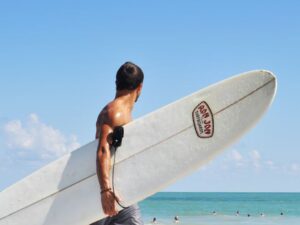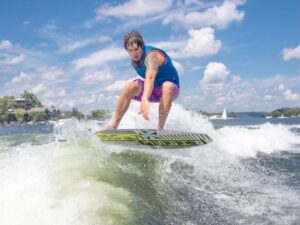Surfing is among the most thrilling and rewarding sports but it can be challenging. From paddling out to the line-up to popping up on your board and riding the wave, there are a lot of skills to master. On top of all that, you gotta be sure you’re catching the right waves.
Catching a wave can be a challenge, even for experienced surfers. You might think you’re in the right spot, but you’ll miss the wave and be left behind because you mistimed your paddle or pop-up.
That’s why it’s important to understand what waves are ideal for surfing and how to catch them. Knowing what to look for and how to position yourself can maximize your chances of catching the perfect wave.
So if you’re ready to take your surfing skills to the next level, read on – I’ve compiled everything I know about finding and catching good waves.
And if you can’t wait, here’s the short version:
A good wave that surfers should aim for must be big and fast enough to carry you with enough momentum but not so much that you can’t catch and ride it. Its shape should be flat and smooth, so you can ride it longer. And the wind direction must be offshore, not onshore.
How to catch a wave when surfing?
Catching a wave is one of the most exciting and rewarding experiences in surfing. However, it can also be one of the most challenging aspects of the sport, especially for beginners who are still learning the basics.
Step 1: Position yourself correctly.
The first step to catching a wave is positioning yourself in the right spot.
Look for a spot where the waves are breaking consistently and avoid areas where the waves are breaking too close to shore or too far out.
For beginners, go to the spots with whitewash. A beach break with a sandy bottom is ideal for newbie surfers.
Position yourself on your board with your chest over the middle and your feet dangling off the tail.
Step 2: Paddle thoroughly and with power.
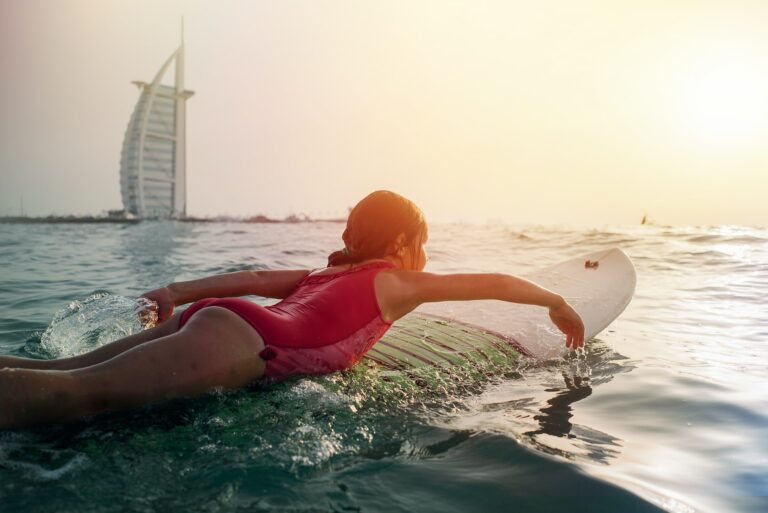
Paddling is the key to catching a wave. Use your arms to paddle with purpose, keeping your fingers together and your hands cupped to create a smoother surface for the water to flow over.
Keep your elbows high and use your back muscles to generate power, paddling straight towards the incoming wave.
Step 3: Timing is everything.
Wait until the wave is close enough before you start paddling harder.
You’ll feel the wave lift the tail of your board, so you’ll know when to paddle harder. Once you feel the tide lift your board, keep paddling to build up speed and momentum.
Step 4: Pop up and have fun.
Once you’ve built enough speed and momentum, it’s time to pop up.
Use your hands to push yourself off the board, landing with your feet shoulder-width apart and your knees slightly bent. Keep your weight centered over the middle of the board, and your eyes focused ahead to maintain balance.
Pro tips for beginners:
- Practice your paddling technique. Use your back muscles to generate power and keep your fingers together to create a smoother surface for the water to flow over.
- Practice timing. Pay attention to the rhythm of the waves and try to anticipate when the next wave will come.
- Ask for help should you need it. Surfing is a community sport, and experienced surfers are often happy to offer tips and advice to beginners.
- Practice adjusting your position and balance. This can be especially challenging on waves with a steep, fast drop or a hollow barrel.
- The key to successfully riding a wave is to pop up quickly and smoothly onto the board. And don’t be discouraged. Catching and riding waves is a skill that takes time and practice to master.
Types of Wave Breaks for Surfing
From beach breaks to point breaks to reef breaks, each type of wave has its own distinct characteristics that make it ideal for different types of surfing.
1. Beach Breaks
One of the most common types, beach breaks, occur when the waves break on a sandy bottom and can offer a variety of conditions depending on the beach’s shape and the waves’ size. Beach breaks tend to be forgiving and offer a soft landing for falls. This makes them an ideal option for beginners still learning the ropes.
However, they can also be unpredictable and inconsistent, making them challenging for experienced surfers looking for more challenging conditions.
Your best bet is to pay attention to the shape of the beach and how the waves are breaking. Look for areas where the waves are breaking consistently. And avoid the ones that are breaking too close to shore or too far out.
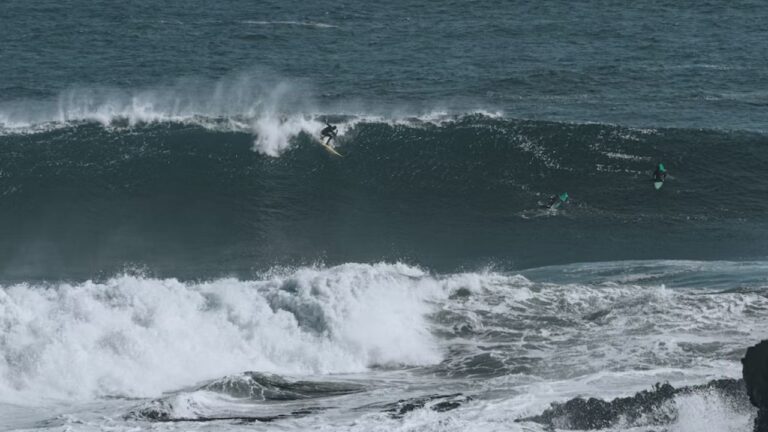
2. Point Breaks
These waves occur when waves break over a point of land, creating a long, peeling wave that can be surfed for hundreds of yards.
Point Breaks tend to be more consistent and offer a longer ride than other types of waves. They can also provide a challenging and rewarding ride for experienced surfers looking for a longer ride and more opportunities to maneuver and control their board.
However, point breaks can also be crowded, as they are popular with surfers of all levels. Accessing them can also be challenging, as they often require a long hike or boat ride.
3. Reef Breaks
These waves can offer a challenging and exciting ride for experienced surfers but can also be dangerous and unpredictable. The best part is that reef breaks offer longer, faster rides than other types of waves.
They also tend to be more consistent than beach breaks, making them an ideal option for surfers looking for a challenge. That said, reef breaks can be hazardous, especially for inexperienced surfers who may be unfamiliar with the currents around the reef.
4. Wedge Waves
Wedge waves occur when two waves converge, creating a steep, powerful wave that can be challenging to surf. These waves can offer a unique and exciting ride for experienced surfers, but they can also be dangerous and unpredictable.
One advantage of wedge waves is that they provide a steep, fast drop that allows surfers to catch air or pull off a trick. However, they can also be difficult to read and maneuver, making them a challenging option for even the most experienced surfers.
What makes a wave good and worth surfing?
As any surfer will tell you, not all waves are created equal. When catching a wave, its size, shape, and speed can make all the difference.
Size
A too-small wave will need more power to carry a surfer, while a too-big wave can be too powerful to handle for beginners. Generally speaking, most surfers prefer waves in the 3-6 foot range, although more experienced surfers may be able to handle larger waves.
Note: The size of a wave is measured in feet, with the face of the wave being the measurement point. When you hear someone say they caught a “6-foot wave,” they’re referring to the height of the wave’s face.
Shape
A good surfing wave should have a smooth, clean face with a long, peeling line. The type of break largely determines the shape of the wave it’s hitting.
A beach break, for example, will produce shorter and steeper waves, while a point break will produce longer, more peeling waves. Reef breaks, meanwhile, are known for producing faster, more powerful waves with a more defined shape.
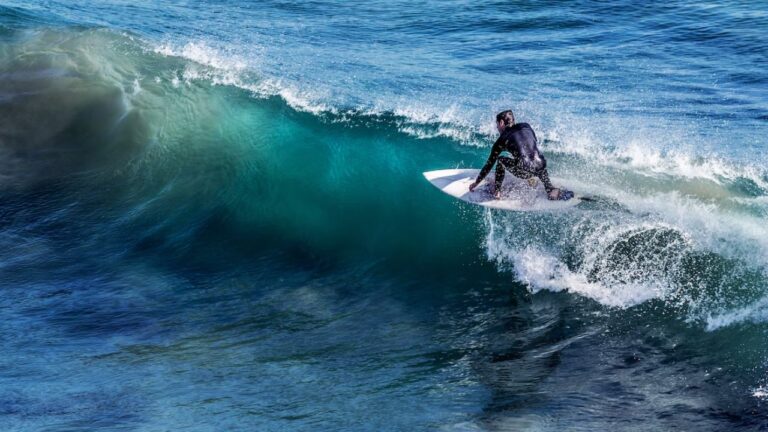
Speed
A too-slow wave won’t provide enough momentum, while a too-fast wave will be difficult to catch and ride. Ideally, a good surfing wave should have a moderate speed that allows surfers to perform maneuvers and ride the wave for as long as possible.
The speed of a wave is largely determined by the swell direction and the slope of the ocean floor. For example, a wave breaking over a shallow reef will be faster and more powerful than a wave breaking over a deep sandy bottom.
Wind Direction
The direction of winds around the shore is easily the most unpredictable and underestimated factor of what makes a wave surfable. For the sake of this explanation, I’ll divide the direction into 3 segments – onshore, offshore, and cross-shore.
- Onshore winds blow in from the sea towards the shore. It causes the wave to crumble and have an undesirable shape. Onshore winds are unsuitable for surfing.
- Offshore winds blow away from the shore and towards the sea, resulting in cleaner wave breaks and a perfect shape. Offshore winds are the best for surfing.
- Cross-shore winds are of three types: cross-on that goes diagonally against offshore, cross-off that go diagonally against onshore, and cross-shore that blow parallel to the shore. All three of these are unsuitable for surfing.
Safety Tips for Beginners
Now, I’m not trying to be a hotshot or anything, but these are some crucial tips (or lessons) that I had to learn the hard way.
The ocean is unpredictable, and even experienced surfers can get into trouble. That’s why prioritizing safety is crucial whenever you hit the waves.
1. Check the conditions before heading out.
This means checking the swell size, wind direction, and tide times. You can find this information online or by asking locals or lifeguards. Understanding the conditions is essential, as they can affect the waves and the current, impacting your safety.
2. Always wear appropriate gear.
You’ll need a wetsuit, leash, and a properly-fitting surfboard. A wetsuit will help keep you warm in cold water, while a leash will ensure you don’t get separated from your board in the water.
Always ensure your surfboard is appropriate for your skill level and the conditions you’ll be surfing in.
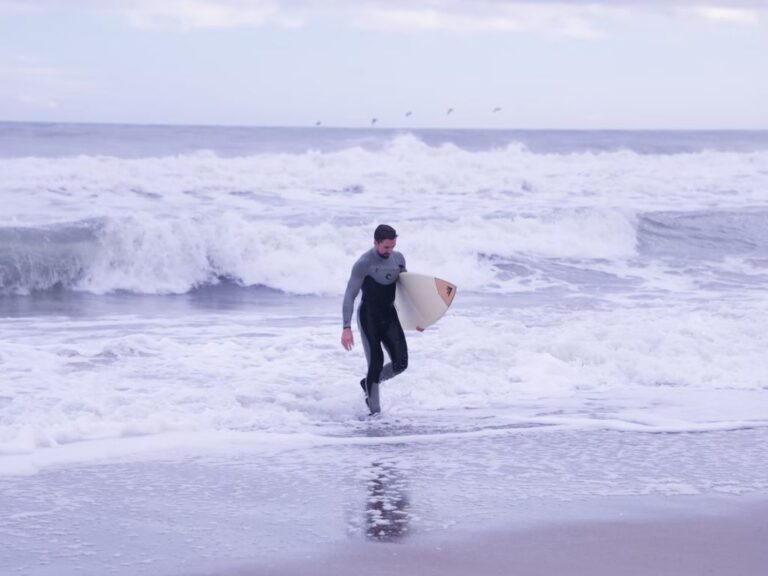
3. Respect other surfers and beachgoers.
Respect for other surfers and beachgoers is critical to maintaining a safe surfing environment. Be aware of others in the water and follow proper surf etiquette.
Refrain from dropping in on other surfers’ waves or hog all for yourself. Always be aware of your surroundings and avoid surfing in crowded areas or around swimmers.
4. Know your limits.
Finally, it’s essential to know your limits as a surfer. Only attempt to surf waves within your skill level, and don’t push yourself too hard.
If you’re tired or unwell, don’t hesitate to take a break or call it a day. Surfing should be fun, but it’s not worth risking your safety or the safety of others.
Expert QnA
Q. Why can't I catch a wave surfing?
First and foremost, don’t worry if you can’t catch a wave. And I commend you for trying to learn and not backing down. Surfing has a MASSIVE learning curve; it’ll take time, but you’ll see exponential growth once you get used to catching waves.
In general, poor timing is the most common reason beginner surfers cannot catch a wave. It makes paddling into the wave and popping up even more challenging than usual. Improper positioning is the second biggest reason on your board if you’re either too far forward or too far back.
Other factors, such as the size and shape of the wave, the wind direction, and your level of experience, can also impact your ability to catch waves.
Q. What is the best position to catch a wave?
The best position to catch a wave while surfing depends on the size and shape of the wave, your level of experience, and your preferred surfing style. As a general rule, you want to position yourself slightly ahead of the breaking point of the wave so that you can paddle into it with enough speed to catch it.
So, you should be lying on your board with your head up and looking towards the shore, with your weight centered and your feet positioned near the board’s tail. As the wave approaches, you’ll want to paddle hard to generate enough speed to catch it and then pop up quickly to your feet.
It’s super important to practice timing and positioning to find the sweet spot for catching waves.
Q. What is the easiest wave to surf?
The easiest wave to surf depends on several factors, including your experience level, the conditions, and the type of wave.
Generally, beginner surfers find it easier to surf on smaller, gentler waves with a consistent shape and easy access, such as those at a beach break or a beginner-friendly surf spot. These waves break gradually and predictably, providing ample opportunity to practice surfing.
Additionally, surfing in calmer conditions with minimal wind and chop can make catching and riding waves easier. As you gain experience and confidence, you can explore more challenging waves and needs to develop your skills and technique further.
Ultimately, the easiest wave to surf is the one that allows you to enjoy the thrill and excitement of riding a wave while feeling safe and confident in your abilities.
Q. How do you catch small waves surfing?
Catching small waves while surfing requires a different approach than with larger waves.
Position yourself closer to the shore, where the smaller waves tend to break. You’ll want to paddle hard and use your legs to generate enough speed to catch the wave as it approaches. As the tide lifts your board, quickly pop up and generate momentum. Finally, just maintain your balance.
It’s crucial to stay centered on your board and evenly distribute your weight, as small waves can be less forgiving than larger ones. Additionally, practicing catching small waves in different conditions and experimenting with different techniques to find the best approach can be helpful.




